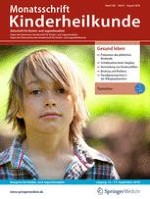Erschienen in:

01.06.2007 | CME Weiterbildung • Zertifizierte Fortbildung
Akute virale Infektionen des unteren Respirationstraktes
verfasst von:
Dr. M. Modl
Erschienen in:
Monatsschrift Kinderheilkunde
|
Sonderheft 02/2007
Einloggen, um Zugang zu erhalten
Zusammenfassung
Virusinfektionen des Respirationstraktes sind ein häufiges Problem sowohl für den in der Praxis als auch für den in der Klinik tätigen Pädiater. Im Besonderen betroffen und gefährdet sind Säuglinge und Kleinkinder. Die häufigsten Erreger sind RS- („respiratory syncytial“), Parainfluenza-, Influenza-, Rhino- bzw. Adenoviren. Dieser Beitrag gibt eine Übersicht über die Ätiologie, Diagnostik und Therapie der häufigsten viral induzierten Erkrankungen des unteren Respirationstraktes wie Krupp, obstruktive Bronchitis/Bronchiolitis bzw. Bronchopneumonie. Die Diagnostik umfasst eine sorgfältige klinische Untersuchung, unterstützt von radiologischen und laborchemischen Methoden. Eine kausale, antimikrobielle Behandlung ist nur beschränkt möglich und lediglich in speziellen Problemsituationen wirksam. Im Vordergrund stehen symptomatische Maßnahmen, die v. a. bei obstruierenden Luftwegserkrankungen von Bedeutung sind. Präventive Maßnahmen stützen sich auf eine aktive oder passive Immunisierung wobei für das gängige Erregerspektrum Impfstoffe nur in beschränktem Ausmaß zur Verfügung stehen.